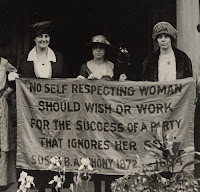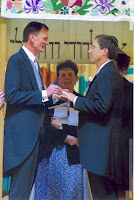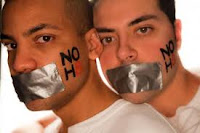[Updated] Today’s so called “protect marriage” advocates have a naively nostalgic view of the history of marriage and how "traditional" marriage has never been redefined. In reality, the legal and societal recognition of marriage has changed and evolved quite a bit over time to include the equal rights of women and racial equality. Soon, I hope, it will include recognition of all loving couples, male/female, male/male and female/female that seek to be legally married.
The California marriage battle has been going on for over a 150 years. Here is a brief history.
The definition of Marriage in California first changed to support women's rights:
 Beginning with statehood, women of California began pushing suffrage. Suffrage meant more then just the right to vote. It was a demand for equality under the law; property rights, guardianship of their children, and access to education. Many saw this as a threat to the traditional institution of marriage. In 1893, state legislature approved suffrage for women but the governor vetoed bill as unconstitutional.
Beginning with statehood, women of California began pushing suffrage. Suffrage meant more then just the right to vote. It was a demand for equality under the law; property rights, guardianship of their children, and access to education. Many saw this as a threat to the traditional institution of marriage. In 1893, state legislature approved suffrage for women but the governor vetoed bill as unconstitutional.A statewide referendum for suffrage was overwhelming defeated in 1896.
Many churches and religious organizations were against woman’s suffrage. To many it signified nothing less than a radical and revolutionary change in our whole social system. It was an assault upon the Family as the social unit based on radically false theory of civil and political rights. It would hurt children and weaken marriages. It was truly a “reform against nature.”Finally in 1911, male voters approved full women's suffrage. California women were finally beginning to be treated as equals in a marriage.
The definition of Marriage in California next changed to support minority rights:
 Anti-miscegenation laws were laws that prohibited the intermarriage and sometimes interracial sex of white people and people of different races.
Anti-miscegenation laws were laws that prohibited the intermarriage and sometimes interracial sex of white people and people of different races.The first California law prohibiting marriages was in 1880. California legislature prohibited the issuance of licenses for marriage between a white person and "a Negro, mulatto (mixed ancestry of black and white), or Mongolian (yellow or Chinese)."
The Japanese were added by special legislation in 1909 to the list of those barred from marrying whites.
Gunjiro Aoki, a Japanese man, was engaged to Helen Gladys Emery, daughter of the archdeacon of San Francisco's Grace Church. The union, touted to be the first interracial Japanese/Caucasian marriage in California, so infuriated local politicians that an emergency session was called in the Assembly to specifically keep the wedding from happening. In order to get married, the couple boarded a train and kept traveling north. At every stop, hordes of people would try to stop their progress. Gunjiro and Helen were finally married by the mayor of Seattle.In 1933, California legislature quickly added “Malays (Filipinos)” as forbidden from marrying whites.
Salvador Roldan challenged the anti-miscegenation law in California on the basis that Filipinos are of the “Malay” race. Roldan won permission to marry his white fiancé. Unfortunately, two months later the Senate amended the anti-miscegenation statute to include the “Malay” race, and all previous marriages between Filipinos and Whites are declared void. The California legislature responded by continually to broaden the prohibition of marriage between whites and any group of Asian Americans.Finally in 1948, the California Supreme Court (activist judges??) ruled in “Perez vs. Sharp,” against the state’s anti-miscegenation laws, stating that they were based on racial distinctions that were "by their very nature, odious to a free people".
Andrea Perez, daughter of Mexican immigrants, fell in love with Sylvester Davis, an African American man. The couple was denied a marriage license by a Los Angeles County clerk. Ms Perez filed suit. This was the first time a state Supreme Count found an anti-miscegenation law unconstitutional.Ten years later in 1958, the first Gallup poll conducted on the subject of interracial marriage revealed that 94% of whites still opposed it. Interracial marriage was considered to be a threat to the traditional institution of marriage. In fact, it wasn't until 1997 that a majority of Americans supported the freedom for interracial couples to marry.
Will marriage change to support the rights of same-sex couples?
 Up until 1974 same-sex intimacy was a crime in California.
Up until 1974 same-sex intimacy was a crime in California.In 1977, the California Civil Code is amended to define marriage as "a personal relation arising out of a civil contract between a man and a woman, to which the consent of the parties capable of making that contract is necessary."
There wasn't a single law recognizing the relationships of same-sex couples until 1984 when the Berkeley School District passed the first one.
Dianne Feinstein, mayor of San Francisco at the time, vetoed an early version of a domestic-partner law in 1982 under intense pressure from the Catholic Church. It was not until 1990 and on its fifth attempt that San Francisco finally passed a domestic-partner law.
In 2000, Proposition 22 passed by 61% to 39%. It added a one-sentence section to the Family Code explicitly defining the union of a man and a woman as the only valid or recognizable form of marriage in the State of California.
The State of California passed in 2003 the first comprehensive domestic partner policy in the United States that was created by a legislature without court intervention. The policy went into effect in 2005.
In 2005 and 2007, the California legislature passed a same-sex marriage bill. Both times Governor Schwarzenegger vetoed it.
Then in May of 2008, California Supreme Court struck down the state's ban on same-sex marriage (Proposition 22) , saying sexual orientation, like race or gender, "does not constitute a legitimate basis upon which to deny or withhold legal rights."
Meanwhile more than 18,000 same-sex couples were married in California between June 17 and November 4, 2008.
 In 2008, Proposition 8 qualified for the fall election. Fueled by misinformation, distortions and lies, millions of voters said YES to bigotry, YES to discrimination, YES to second-class status for same-sex couples. The proposition was heavily funded by the Mormon and Catholic Churches. It passed with by small majority of 52.5% and was the most expensive proposition on any ballot with over $85 million spent by both sides. The proposition changed the California constitution to eliminate the right of same-sex couples to marry in California. A new section is added stating "only marriage between a man and a woman is valid or recognized in California."
In 2008, Proposition 8 qualified for the fall election. Fueled by misinformation, distortions and lies, millions of voters said YES to bigotry, YES to discrimination, YES to second-class status for same-sex couples. The proposition was heavily funded by the Mormon and Catholic Churches. It passed with by small majority of 52.5% and was the most expensive proposition on any ballot with over $85 million spent by both sides. The proposition changed the California constitution to eliminate the right of same-sex couples to marry in California. A new section is added stating "only marriage between a man and a woman is valid or recognized in California."2009: California Supreme Court upheld Proposition 8, constitutionally defining marriage between a man and a woman, but rules that previously officiated same-sex marriages shall remain valid.
2010: U.S. District Court of Northern California declared that Proposition 8 violates due process and Equal Protection clauses in the U.S. Constitution. Supporters of the proposition appeal to the United States Court of Appeals for the Ninth Circuit.
2012: Federal Court of Appeals for the Ninth Circuit ruled 2-1 that Proposition 8, violates the Equal Protection Clause of the United States Constitution. Judge Stephen Reinhardt wrote in the decision, “Proposition 8 serves no purpose, and has no effect, other than to lessen the status and human dignity of gay men and lesbians in California."
The case is now one step closer to US Supreme Court.

1 comment:
This is a good well researched article. I thought that California was more progressive. Perhaps the way to look at it is that Proposition 8 is but a temporary setback. Sometimes setbacks turn out to be the best thing that could have happened. Keep at it.
Post a Comment